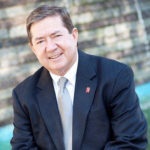Spanish Flu Pandemic
by Drew Edmondson
It appears that the “Spanish Flu” pandemic of 1918 may have begun just north of Turpin, Oklahoma, on Highway 83, in Haskell County, Kansas.
As Rotarians do their part by social distancing, wearing face coverings not so much to protect themselves but to protect each other, and wait for an effective vaccine, we might contemplate what the country has gone through before. In this instance, 100 years ago.
There has been a great deal written about the course of that pandemic in the United States and on to Europe and the rest of the world. The statistics are sobering: upwards of 50 to 100 million deaths worldwide, 675,000 deaths in the United States after four separate waves of infection (compare almost 200,000 deaths from Covid-19 in the U.S. today).
There was an article written in the Smithsonian Magazine, November, 2017, that pointed to Kansas as the source of the “Spanish Flu.”
Written by John M. Barry, American author and historian, the article discusses Haskell County as being in a major migratory bird pattern and a location where hog farming was prevalent. Scientists know that bird viruses can infect hogs, as can human viruses. When both are present a mutation can occur which is particularly lethal. There is circumstantial evidence that this is what happened, just north of the Oklahoma panhandle.
We do know that an influenza outbreak hit Haskell County in January 1918 because a local doctor, Loring Miner, alerted the U.S. Public Health Service (the Centers for Disease Control in Atlanta did not come into being until July, 1946). And, a local newspaper, the Santa Fe Monitor listed a number of the sick by name and added, “Most everybody over the country is having lagrippe or pneumonia.”
World War I was underway and Camp Funston in central Kansas was training soldiers. Several from Haskell County who had been exposed to the sickness went there. On March 4, Camp Funston had its first reported casualty and within two weeks 1,100 had been admitted to the hospital. Soldiers from Funston went to other Army bases and 24 of 36 large camps had outbreaks.
The disease spread to civilian communities and the soldiers took it overseas to Europe.
The war contributed to the spread in more ways than one. The war had taken doctors from all over the country, and some of the best ones, to meet the needs of battle but, in the process, left civilian hospitals short-handed. The war moved people from their hometowns to different states and different countries, facilitating the pandemic.
Perhaps most perniciously, at President Wilson’s urging, Congress passed the Sedition Act, making it a 20 year felony to defame the country. Posters urged people to report anyone who spread pessimistic stories. So, we did not report what was appearing to be an epidemic of a lethal disease.
The allies generally had similar policies, so, as the epidemic became pandemic, no warnings issued from Great Britain, no alarms were raised in France, or anywhere else for far too long as the “Spanish Flu” moved to claim an estimated 50 to 100 million lives.
Until the virus hit Spain. When the virus swept through Spain infecting, among others, the King, it made news. Spain was not in the war and the press wrote freely about the disease and its massive impact. That news reached the world and the virus became the “Spanish Flu”
The Smithsonian article was written two years before Covid-19 hit China and additional months before we heard about it in the U.S.
In early 2017, as he left office, the head of the Centers for Disease Control and Prevention, Tom Frieden, was asked what kept him up at night, what really worried him, his reply: “The biggest concern is always for an influenza pandemic….(It) really is the worst-case scenario.”
Rotarians, once again, set a good example. We save lives.


Thank you, Drew – GREAT ARTICLE!
My vote for “Column of the Year!”
In the U.S. in the midst of the then-so called Epidemic, we were experiencing similar public unrest as today; strikes, mob violence in most large cities blamed on Bolsheviks, terrorist, anarchy and subversion!
Thank you Drew!